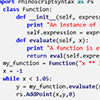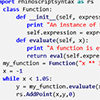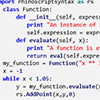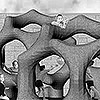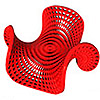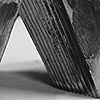In this session, I will add two new methods to the Vector class. I think this will finish the basics for the vectors. In the future, we are going to need several new methods like adding multiple vectors and interpolation. But for now, I think this would be sufficient to further advance into parametric curves and surfaces. These new methods will be based on the dot product method we created […]
Posts categorized under Design Mathematics
This is the continuation of the Vector class we started here, and further advanced here, here, and here. This new Rhino Python implementation is mostly educational and partially a hobby. Before this session, we have developed display, magnitude, add, multiply, reverse, and subtract methods. This time, I am adding the vector normalization and dot product methods and seeing the utilizations of the dot product. Line Explanation 1-26 Already explained in […]
Today, I am going to make only one addition to the Vector class we recently started in Rhino Python. The magnitude of a vector can be easily calculated by assuming that the axes (2 or 3 axes) of it are perpendicular to each other. This gives us an opportunity to assume a right triangle visually, and calculate the magnitude (length) of a vector by using the Pythagorean Theorem. In short, […]
This is the continuation of my new project of re-creating the parametric curve and surface methods of Rhino via Python scripting. If you remember, I started with the building block of vector operations, here and here. Then, I defined vector addition and multiplication, before going deeper into the geometric calculations. In fact, they are using the previously defined addition and multiplication methods. New Vector Operations: Subtraction and Reversing In the […]
Today, I am going to advance the Vector class a bit more. Firstly, I will improve the display method I introduced recently. Then, I will add two new methods which handle the fundamental vector arithmetics in Rhino Python. Improving the Display Method In the previous attempt, I displayed vectors on the origin of the Rhino viewport. The coordinates of the tail of a vector are not stored within the object […]
Let’s continue from the Vector class that started yesterday. Previously, I defined this class to store three numbers (coordinates), named as “components”. I defined a method named __init__ for this. Similarly, I am adding a display method to the Vector class today. Note that I am using Rhino 6 in this code, but it should also work in Rhino 5 or 7. The code Below is the line-by-line explanation of […]
In this new series, I will be using Rhino Python to create some of the fundamental mathematical objects in Rhino. We will learn how to code in Python, and also try to get deeper into the intuition behind some of the fundamental concepts we use every day in Rhino and Grasshopper. The Vector class in Rhino Python is the starting point of this journey. Just like vectors, most of the […]
Below are some of the student works from the 2018 course: Design Mathematics. The final project of the course was about experimenting the designerly creativity. This included utilizing the mathematical concepts and objects studied throughout the semester. This was a rather open-ended homework question. But in the following years, I am not planning to repeat it. Because it becomes difficult to assess the learning outcome from open-ended homework within such […]
In Design Mathematics 2019 course, Berke Çelik designed the Enneper Slide in his final project. The Enneper surface is an interesting case since it is a minimal surface with potential variations for spatial implementations. Berke used Rhino Math and Grasshopper / Weaverbird to generate his design. I think the Enneper Slide, as a minimal surface, is an exciting start for a Design Mathematics student work. But as always, much more […]
Today, I am introducing a student work from the Design Mathematics course. Foad Sarsangi is a very talented designer, who attended my elective course last semester. The final project he studied was inspired by Peter Zumthor’s Bruder Klaus chapel. Foad wanted to experience its special production process. However, as the course was about “mathematics”, he also studied, solved, and generated an interior volume to be subtracted from a solid mass. […]
Jumping into the world of mathematics as a designer seemed to be frightening at the beginning but I opened a new elective course at Bilgi, Design Mathematics. Starting today, I’ll try to log my experiences with the students while we are trying to understand mathematics. The ultimate objective is to find paths that may lead to answering the following question; “what is the relationship between design and math”? Next week, […]

